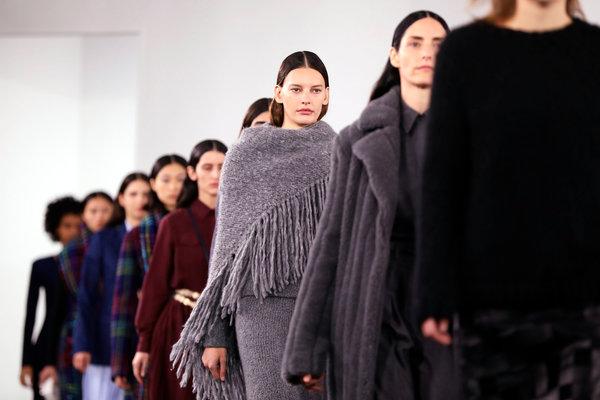
Gabriela Hearst, fall 2019.CreditStefania Curto for The New York Times
Last November, when the final season of “House of Cards” premiered with Robin Wright as Claire Underwood in the Oval Office as the first female president, Kemal Harris, the wardrobe designer, revealed that she had made most of the president’s outfits herself because she couldn’t find what she needed on the runway. Fashion, she said, simply wasn’t catering to a woman in charge.
It’s interesting to think about that in the context of the New York shows, which draw to a close Wednesday. After all, there are more women — five! — already in the race for the Democratic presidential nomination than ever before (And even more female faces in Congress). Presumably, they will be under some pressure to support local industry, even if the current first lady does not seem to feel the same way. And the looks on the runways will hit stores just as the debate season begins, which means what we have seen this week will be what these women will see when they are mulling over the thorny question of how to dress on stage — or in public.
(And they will think about it, whether we like it or not. It’s part of conveying their message; see the recent State of the Union. The same is true for men; their options are just more limited.)
So many change agents, all in need of clothes! Did designers give them something to wear?
Kind of. When even Vaquera, the outsider brand that’s a dab hand at messing with the twin totems of authority and the everyday, suddenly starts playing around with banker striped shirting, you know something is going on. To be fair, it also played with wearable lampshades and mop-head shoulders, but still.
Issues of confidence and self-definition, two crucial components of empowerment, are emerging on the edges and the establishment. Roomy, swishy trouser suits also: They’re one of the few trends, besides a major focus on the sleeve. The traditional power suit, however? Not so much. That’s O.K.
President Underwood might have been pleased at the multitude of sharp-edged trench coats at Gabriela Hearst, who built her collection around imagining the life of Maya Plisetskaya, the Russian ballerina who grew up in a gulag and, as the show notes said, “was a woman of style, resourceful in a scarce environment.” She might have seen strength in the herringbone trouser suit with red pinstripes.
But even more interesting were the nubby sweaters and mid-calf skirts, worn under a grand scarf with dangling fringe, the supple leathers and long thin-knit Martha Graham dresses, all of which spoke softly of a more internal sense of security but wielded a pretty strong punch. Don’t underestimate it.
It’s worth nothing that, as a designer, Ms. Hearst has long been interested in the thorny issue of fashion and sustainability — she uses recycled cashmere and works with local artisans in Uruguay, where she grew up — and in her front row were two special guests, Kelsey Juliana and Levi Draheim, who are part of a lawsuit seeking to require the Trump administration to implement climate change legislation. Ms. Hearst’s clothes may look restrained but are made by, and for, someone who doesn’t shy away from a fight.
Just as Maria Cornejo, another longtime proponent of sustainability in fashion, has found fortitude in the ease of a bronze silk doppio sweatshirt over matching pleated pants, a hammered silk drop-waisted flapper dress and a deep-pile corduroy dress. They don’t demand too much but they have backbone.
And they have pockets!
So did the Bermuda shorts at Coach. They were tailored or transparent, worn under all the flyaway floral dresses (prints by the California artist Kaffe Fassett), buffalo-plaid coat, fringed leather and shearling, and atop all the truncated cowboy boots. That’s more for the youth vote, admittedly.
It’s a shift in emphasis — the idea that security doesn’t have to come from structure but instead can be derived from ease — taking place even at Oscar de la Renta, one-time favorite design house of Hillary Clinton and one of the few brands in New York seemingly still trying to serve a more heritage clientele. See the classic tweeds that appeared, before the designers Fernando Garcia and Laura Kim went on an extended riff inspired by trips to the Middle East and the founder’s Spanish roots, melding the influence of the two.
If sometimes the references veered to the overly literal and decorative (magic-carpet prints taken from actual carpets and jewel-bedecked evening gowns), there were also spice-market shades and scarf-trimmed tunics to cut the rigidity of the tailoring; Alhambra tile-pattern velvets laid atop tulle; and tuxedo pants topped by asymmetric lace for evening, for some no-fuss froth.
For those who really want to change the rules of the game, however, there’s always Batsheva, the brand that shot to recognition with its embrace of the prairie dress and its determined rejection of the male gaze via ruffled necks, little-girl prints, puffed long sleeves and full skirts. This season Holly Hobbie knickerbockers and pinafores were added to the mix.
Wear one of those on the hustings and an opponent might actually be rendered speechless. That’s power dressing, of a kind.







